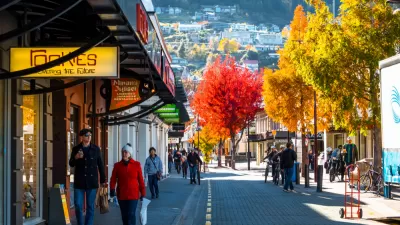An innovate plan to reconceive Auckland's transit network from the ground up led by Jarrett Walker demonstrates the dramatic efficiencies that can be gained, without additional cost, by increasing transfers.
In a new post on his Human Transit blog, Walker discusses the simple geometries behind the ambitious redesign of Auckland's public transit network that he's authored with planners from Auckland Transport and his colleagues at MRCagney.
For the same operating costs as the city's existing network, Walker's proposed plan, "defines an extensive network of high frequency
services around which future urban growth can organize to ensure that
over time, more and more of the city finds public transport convenient." Images of the existing network and the proposed plan demonstrate the dramatic expansion of access.
"What's the catch?", asks Walker. "Only the geometrically inevitable one:
more people will have to make connections from one service to another,
and the fare system will need to encourage rather than penalise that."
"Networks that are designed to prevent transferring must run
massive volumes of half-empty and quarter-empty buses and still have
trouble delivering frequencies that make the service worth waiting for.
The waste involved can be colossal, as you can see from the amount of
service we were able to redeploy in more useful ways with this redesign."
FULL STORY: auckland: how network redesign can transform a city's possibilities

Trump Administration Could Effectively End Housing Voucher Program
Federal officials are eyeing major cuts to the Section 8 program that helps millions of low-income households pay rent.

Planetizen Federal Action Tracker
A weekly monitor of how Trump’s orders and actions are impacting planners and planning in America.

Ken Jennings Launches Transit Web Series
The Jeopardy champ wants you to ride public transit.

California Invests Additional $5M in Electric School Buses
The state wants to electrify all of its school bus fleets by 2035.

Austin Launches $2M Homelessness Prevention Fund
A new grant program from the city’s Homeless Strategy Office will fund rental assistance and supportive services.

Alabama School Forestry Initiative Brings Trees to Schoolyards
Trees can improve physical and mental health for students and commnity members.
Urban Design for Planners 1: Software Tools
This six-course series explores essential urban design concepts using open source software and equips planners with the tools they need to participate fully in the urban design process.
Planning for Universal Design
Learn the tools for implementing Universal Design in planning regulations.
Ada County Highway District
Clanton & Associates, Inc.
Jessamine County Fiscal Court
Institute for Housing and Urban Development Studies (IHS)
City of Grandview
Harvard GSD Executive Education
Toledo-Lucas County Plan Commissions
Salt Lake City
NYU Wagner Graduate School of Public Service




























